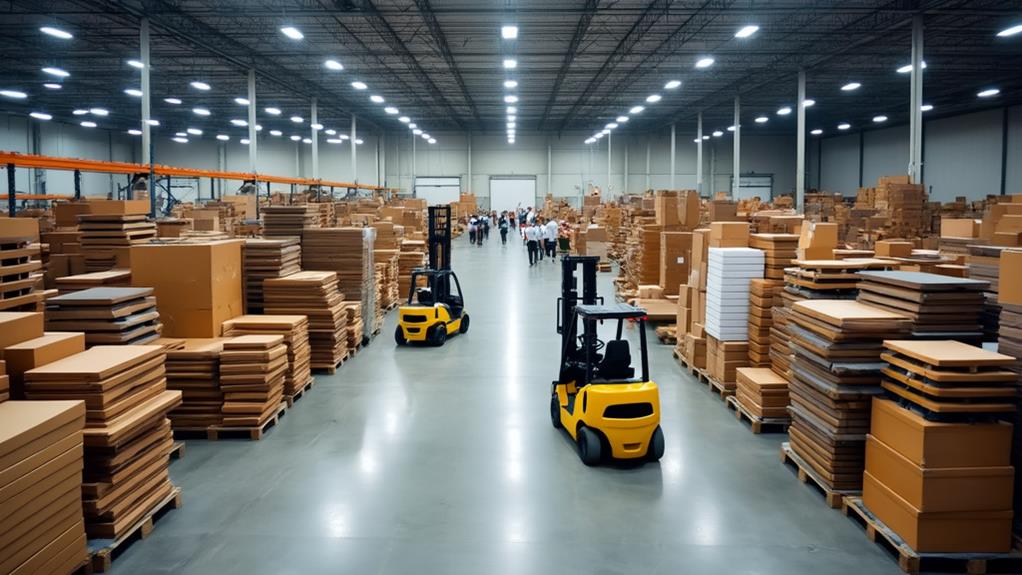Mastering bulk furniture delivery logistics requires strategic planning and implementation across various facets. Optimizing shipping methods involves choosing between LTL or FTL options based on size and distance. Managing delivery timeframes with realistic schedules enhances customer trust. Selecting the right carrier with a strong punctuality record impacts efficiency. Advanced tracking technologies provide shipment visibility, while compliance with import/export laws guarantees smooth international operations. Warehouse efficiency is improved with a well-organized layout and effective use of WMS. Coordination with assembly services and investing in staff training are also essential. Exploring these elements further can reveal additional strategies for success.
Table of Contents
ToggleOptimizing Shipping Methods
In the domain of bulk furniture delivery, optimizing shipping methods is essential for balancing cost efficiency and timely delivery. Selecting the appropriate shipping method requires evaluating size, weight, and distance.
Less-than-truckload (LTL) shipping allows cost-sharing for smaller shipments, making it a practical option for medium-sized orders. On the other hand, full truckload (FTL) shipments are ideal for large quantities, providing economies of scale.
Expedited shipping can be employed for urgent deliveries, though it often incurs higher costs. Conducting a cost-benefit analysis, including storage and handling, is important to maintaining profitability.
Managing Delivery Timeframes
How can companies effectively manage delivery timeframes to secure customer satisfaction and operational efficiency?
Setting realistic delivery schedules is vital, aligning them with logistics capabilities to prevent over-promising. Transparent communication with customers about expected timelines helps manage expectations, guaranteeing they are informed of any potential delays due to geographic obstacles or high order volumes.
To minimize late deliveries, methodical planning and verification of accessibility to final delivery locations are essential steps. Companies should also assess potential obstacles and plan alternative routes if accessibility issues arise.
This approach not only improves operational efficiency but also enhances customer satisfaction. Timely deliveries foster trust and reliability, while preparedness for unforeseen challenges secures a seamless delivery experience, reinforcing the company's reputation for dependability.
Choosing the Right Carrier
Selecting the appropriate carrier is a critical decision that considerably impacts the efficiency and reliability of furniture delivery logistics. To guarantee peak service, assess carriers' track records for punctuality and the suitability of their equipment for handling bulky items.
Analyze their capacity to adapt to fluctuating order volumes, ensuring they can accommodate both high-demand periods and slower times. Evaluate the protective measures they employ during transport to safeguard furniture integrity.
Additionally, consider their commitment to customer service and sustainability, as these factors can enhance brand reputation. Establish clear communication channels to set delivery expectations, and guarantee they understand any timing or spatial constraints.
Partnering with the right carrier is pivotal for maintaining seamless, reliable logistics operations, ultimately supporting customer satisfaction.
Leveraging Tracking Technology
While the complexity of furniture delivery logistics continues to grow, leveraging advanced tracking technology is imperative for maintaining operational efficiency and enhancing customer satisfaction.
Real-time tracking systems provide critical visibility into the status and location of shipments, enabling businesses to manage deliveries more effectively. These technologies reduce uncertainties by offering accurate delivery estimates, which is essential for maintaining customer trust.
The integration of Internet of Things (IoT) devices enhances inventory management by tracking shipments from origin to destination. Data analytics further optimize supply chain operations, allowing for proactive identification of potential delays.
Additionally, mobile applications streamline communication among logistics teams, ensuring seamless coordination. Overall, the adoption of these technologies leads to improved efficiency, reduced errors, and elevated customer service standards.
Navigating Import/Export Compliance
Maneuvering the complex landscape of import/export compliance is essential for businesses engaged in international furniture delivery to avoid potential legal challenges and guarantee smooth operations.
Thorough understanding and adherence to diverse global regulations are critical to steering these waters effectively. Compliance involves several key aspects:
- Documentation: Confirm accurate preparation of manifests, bills of lading, and other necessary paperwork to facilitate customs inspections and avoid delays.
- Tariffs and Classifications: Familiarize with tariff structures and the Harmonized System (HS) codes to correctly classify goods, impacting duty rates and overall costs.
- Customs Brokers and Legal Expertise: Engage experienced customs brokers and legal advisors to simplify complex regulatory requirements, confirming conformity and minimizing risks.
These steps foster seamless import/export processes, enhancing operational efficiency.
Enhancing Warehouse Efficiency
As businesses successfully navigate the complexities of import/export compliance, attention must also be directed toward optimizing warehouse efficiency to secure the smooth flow of goods.
A key strategy involves the implementation of a Warehouse Management System (WMS), which supports real-time inventory monitoring and distribution. This technology enables precise tracking and data-driven decision-making, reducing errors and enhancing operational efficiency.
Additionally, optimizing warehouse layout plays an essential role; strategic shelving and stacking not only maximize storage capacity but also facilitate quick access to high-demand items. Regular assessments and adjustments guarantee that the warehouse adapts to changing inventory needs.
Coordinating Assembly Services
In the domain of bulk furniture delivery, coordinating assembly services emerges as a critical value-add that greatly enhances customer satisfaction. The integration of assembly services requires meticulous planning, ensuring that every step aligns seamlessly with delivery schedules.
This coordination involves several key components:
- Reliable Assembly Teams: Establish partnerships with skilled and dependable assembly personnel, guaranteeing high-quality workmanship and adherence to manufacturer guidelines.
- Clear Communication: Clearly outline assembly options during the sales process, allowing customers to make informed decisions, which in turn streamlines the overall delivery experience.
- Scheduling Synchronization: Align assembly timing with delivery schedules to minimize customer wait times, enhancing the post-delivery experience.
Boosting Customer Satisfaction
Building upon the coordination of assembly services, enhancing customer satisfaction becomes paramount in the bulk furniture delivery sector.
Effective communication is a vital element, ensuring customers are informed throughout the delivery process. Providing timely updates on delivery status, including potential delays, fosters transparency and trust.
Implementing feedback mechanisms enables companies to pinpoint logistical shortcomings, allowing for targeted improvements. Personalizing customer interactions, such as addressing specific delivery preferences, further elevates the customer experience.
Post-delivery follow-ups are essential to confirm satisfaction and address any arising issues promptly. By focusing on these elements, businesses can build a loyal customer base, encouraging repeat business.
Ultimately, prioritizing customer satisfaction not only enhances reputation but also drives profitability and long-term success in the competitive furniture delivery industry.
Selecting Delivery Vehicles
Choosing the right delivery vehicles is vital for enhancing the logistics of bulk furniture delivery. The vehicle selection process should factor in several important considerations to guarantee efficiency and cost-effectiveness.
First, the size and weight of furniture items must dictate the choice of vehicle, as mismatches can lead to increased costs or delivery failures.
Second, vehicle capacity should align with the volume of goods transported, maximizing space utilization and minimizing trips.
Third, accessibility features such as lift gates or ramps are essential for locations with challenging entry points.
- Furniture Size and Weight: Confirm vehicles can accommodate the dimensions and mass of items.
- Capacity and Volume: Match vehicle capacity to shipment size for maximum efficiency.
- Accessibility Features: Equip vehicles with necessary tools for various delivery environments.
Investing in Staff Training
Effective staff training is essential for optimizing logistics operations in bulk furniture delivery. Investing in training programs enhances employee efficiency and safety, which are vital for handling large-scale deliveries.
Cross-training staff allows for operational flexibility, ensuring that employees can adapt to various roles as demand fluctuates. Regular workshops on new technologies keep teams updated, promoting the integration of advanced logistics solutions.
Emphasizing quality control practices minimizes errors, contributing to smoother delivery processes. Additionally, fostering a culture of continuous improvement through employee feedback encourages innovation and commitment to excellence.


